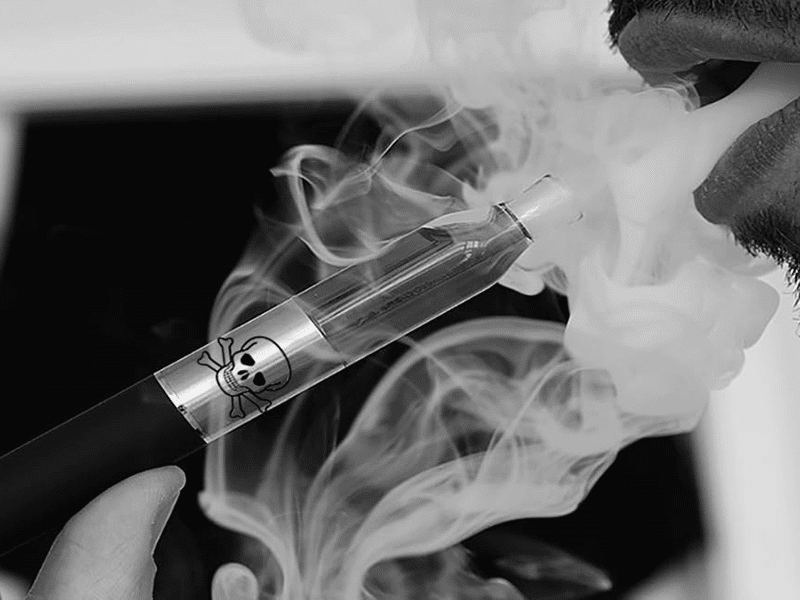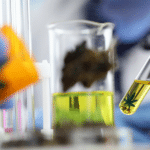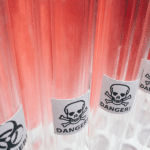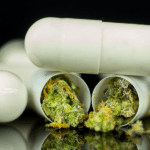It wasn’t so long ago that a frightening new lung disease linked to vaping dominated the news cycle. Although it might feel like a distant episode to Americans overwhelmed by COVID-19, during the summer of 2019 the vaping crisis became a national obsession. The Centers for Disease Control (CDC) issued an alarming report that attributed a sudden outbreak of deaths and pulmonary injuries to the consumption of harmful e-cigarettes and cannabis vape pen cartridges.1
By February 2020, sixty-eight people in the United States, including teenagers and seniors, had died because of this mysterious respiratory illness and nearly 3000 were hospitalized with problems ranging from shortness of breath to severe nausea and coughing up blood. The CDC identified vitamin E acetate, a thickening agent added to poor quality cannabis oil extracts, as the likely culprit in cases of respiratory failure linked to vaping.2
But the CDC stopped tracking vaping-related incidents shortly after the onset of the COVID-19 pandemic. Medical scientists turned their attention to the highly infectious coronavirus, which also kills by damaging the lungs – and does so in ways that aren’t easy to distinguish from the telltale signs of vaping.
COVID-19 and EVALI (the CDC’s acronym for e-cigarette or vaping-related lung injuries) have similar symptoms and share a common lethal mechanism. Severe cases of both diseases involve acute respiratory distress triggered by an immune system gone haywire. Medical scientists refer to this potentially fatal immune syndrome as a “cytokine storm.”
Vitamin E Acetate
We know that a voracious coronavirus can induce a cytokine storm. But what do we actually know about vitamin E acetate and vaping?
According to the CDC: “Vitamin E acetate is strongly linked to the EVALI outbreak. Vitamin E acetate has been found in [vape] product samples tested by FDA and state laboratories and in patients’ lung fluid samples tested by CDC from geographically diverse states.”3
EVALI patients have been diagnosed with lipid pneumonia, a rare inflammatory condition that occurs when fat or oil enters the alveolar sacs of the lungs. This causes symptoms similar to other kinds of pneumonia, which is usually triggered by a bacterial, fungal or viral infection.
In a 2020 mouse study, vitamin E acetate appeared to replicate the lipid-associated lung damage of EVALI, lending support to the CDC’s contention that vitamin E acetate is a causative factor in vaping-related lung disease. Investigative reporting by Leafly also zeroed in on vitamin E acetate “among a gang of toxins” identified in illicit vape cartridges, including squalene, a skin cream ingredient, that shouldn’t be inhaled.4
But a commentary in the New England Journal of Medicine, coauthored by a team of Mayo Clinic physicians, cast aspersions on the vitamin E acetate hypothesis, noting that the pathology of vaping-associated lung illness “is poorly understood” and that “few reports of vaping-associated lung injury have included histopathological findings.” A histopathological diagnosis is based on direct examination of diseased tissue or cells under a microscope.5
Upon inspection, some cases of vaping-associated lung injury look more like a chemical burn than lipid suffocation – which suggests that additives other than vitamin E acetate are responsible for damaging lung tissue. Accordingly, another group of doctors advised in a letter to the Journal of American Medicine that the presence of lipid-laden immune cells in the lungs “should be interpreted with caution because it may merely be a marker of exposure rather than a marker of toxicity.”6
Vape Oil Additives
Project CBD has been beating the drum about potential hazards of vape oil additives for several years. Thinning agents, such as propylene glycol and polyethylene glycol, and all manner of flavoring additives (staples of the ultra-processed food industry) are approved by the Food and Drug Administration (FDA) as safe for oral consumption. But many of these FDA-authorized texturizing agents and artificial flavors are poisonous when heated and inhaled.
A 2018 study by scientists at the University of Rochester found that exposure to commonly used vape oil and e-cigarette flavoring agents is toxic to white blood cells. Among the worst offenders is diacetyl, a chemical added to e-cigarette and vape oil cartridges to simulate a creamy, buttery or vanilla-like flavor. Inhaling this chemical is known to cause “popcorn lung,” a crippling and sometimes fatal respiratory illness.7
A report by Yale University researchers showed that combining chemical flavoring agents is more dangerous than exposure to a single additive. All bets are off when you also add thinning and thickening agents, like propylene glycol and vitamin E acetate, into the mix. It’s not known to what extent these sketchy chemical cocktails contributed to last year’s EVALI outbreak – or if they are a factor in sporadic cases of vaping-related lung injury that continue in the COVID-19 era with little comment from the CDC.8
In Under the Radar: Synthetic Cannabinoids and Vaping Related Lung Injuries, a special report published in November 2019, Project CBD drew attention to another group of dangerous compounds that have been overlooked by the CDC. An extensive literature review by Adrian Devitt-Lee, Project CBD’s chief science writer, found several examples of case reports that involved exposure to “synthetic cannabinoids,” a class of difficult-to-detect and potentially lethal research-turned-street compounds, which wreak havoc by disrupting the endocannabinoid system. All of these case reports showed a consistent set of symptoms (ground glass opacities, ruptured blood vessels, oxygen deprivation as lungs fill with fluid, etc.) that align with the CDC’s diagnostic criteria for vaping-related pulmonary disease.9
Synthetic Cannabinoids
A recent study by University of Mississippi scientists in the Journal of Dietary Supplements confirmed the presence of synthetic cannabinoid adulterants in illicit vape oil cartridges. The Mississippi investigators analyzed the content of 25 commercially available hemp-derived vape oil products. Of these, thirteen products contained less than 50 percent of the amount of cannabidiol (CBD) that was indicated on the label; only 3 products contained within 20 percent (plus or minus) of the CBD content claimed on the label; and 3 “CBD” products had no measurable cannabidiol whatsoever.10
“From the consumer’s perspective,” the authors noted, “over-labeling not only misrepresents the product but also signifies fraudulent business practices.” Even more disconcerting “was the frequency with which CBD vaping products were adulterated with synthetic cannabinoids.” Four out of 25 randomly selected CBD vape products sold in the Magnolia State contained synthetic cannabinoids that pose “a serious risk for adverse health effects” with “devastating toxicological consequences,” according to the University of Mississippi researchers.
It’s uncertain whether this small study is emblematic of the prevalence of synthetic cannabinoid adulterants within the sprawling, unregulated, international vape market. But this much is clear: synthetic cannabinoids warrant careful scrutiny when considering the multiple factors that may contribute to vaping-related lung injuries and how best to respond to this ongoing public health issue.
If synthetic cannabinoids are indeed a missing piece of the EVALI puzzle, as Project CBD proposed last year, then why does vitamin E acetate keep popping up as “a marker of exposure rather than a marker of toxicity” in vape oil cartridges? Because it’s cheaper for bad actors who make fake cannabis oil to start with a thinning agent like propylene glycol, spike it with a tiny dose of a super-potent synthetic cannabinoid, and then add a glop of vitamin E acetate to thicken the liquid so it has the right consistency for a vape pen.
Unregulated Markets
Vaping is a convenient, discreet, fast-acting, and easy-to-titrate method of consuming cannabis. Fortunately there are good quality vape options for consumers who live in states where cannabis is legal for adult use. But the pickings are slimmer and riskier in “CBD-only” states, where whole plant cannabis oil extracts are not yet available through regulated channels.
Vitamin E acetate is seemingly everywhere because poor quality vape products proliferate in the unregulated CBD and cannabis oil market. In addition to vitamin E acetate, illicit CBD vape cartridges typically include a CBD isolate dissolved in a carrier oil (usually MCT, glycerin or propylene glycol) that’s not safe to heat and inhale. Such products are just a mouse click away and can be purchased at gas stations, head shops, and other storefronts that also sell nicotine e-cigarettes, which are laced with many of the same flavoring and texturizing additives found in unlicensed CBD and cannabis oil blends.
Cannabis has been smoked for centuries without causing the freakish and sometimes fatal symptoms linked to toxic vape oil exposure. According to a recent Yale University School of Public Health study, vaping-related lung disease is much less prevalent in states that have legalized cannabis. Consumers in the five states with the highest per capita incidence of EVALI do not have access to regulated, lab-certified vape oil products made by state-licensed manufacturers.11
The bottom line: the existence of a legal, regulated cannabis market, warts and all, reduces the use of dangerous vape oil cartridges.
Martin A. Lee is the director of Project CBD. He’s authored and edited several books, including Smoke Signals, Acid Dreams, and The Essential Guide to CBD. © Copyright, Project CBD. May not be reprinted without permission.
Footnotes
- Centers for Disease Control and Prevention, “Sounding the Alarm: The Public Health Threat of E-Cigarettes,” Sept. 25, 20019
- Centers for Disease Control and Prevention, “Outbreak of Lung Injury Associated with the Use of E-Cigarette, or Vaping, Products,” Feb. 25, 2020.
- Centers for Disease Control and Prevention, “Outbreak of Lung Injury Associated with the Use of E-Cigarette, or Vaping, Products,” Feb. 25, 2020.
- David Downs, “VAPI anniversary: Killer chemicals still on the streets,” Leafly, Aug. 4, 2020.
- Yasmeen M Butt, MD, et al, “Pathology of Vaping-Associated Lung Injury,” New England Journal of Medicine, Oct. 31, 2019.
- Kulothungan Gunasekaran, et al “Lipid-Laden Macrophages in Cannabinoid Oil Vaping Associated Lung Injury,” Letter to the editor, The American Journal of Medicine, https://doi.org/10.1016/j.amjmed.2019.11.025
- Muthumalage, Thivanka, et al. “Inflammatory and Oxidative Responses Induced by Exposure to Commonly Used e-Cigarette Flavoring Chemicals and Flavored e-Liquids without Nicotine.” Frontiers in Physiology, 11 Jan. 2018, www.frontiersin.org/articles/10.3389/fphys.2017.01130/full.
- Eythropel, Hanno C, et al. “Formation of Flavorant–Propylene Glycol Adducts With Novel Toxicological Properties in Chemically Unstable E-Cigarette Liquids.” Nicotine and Tobacco Research. 2019 Aug 19;21(9):1248-1258. doi: 10.1093/ntr/nty192.
- Adrian Devitt-Lee, “Under the Radar: Synthetic Cannabinoids and Vaping Related Lung Injuries,” published online Nov. 11, 2019, https://projectcbd.org/safety/under-the-radar-synthetic-cannabinoids-evali/.
- Bill J. Gurley, et al, “Content versus Label Claims in Cannabidiol (CBD)-Containing Products Obtained from Commercial Outlets in the State of Mississippi,” Journal of Dietary Supplements, published online 20 May 2020, https://www.tandfonline.com/doi/full/10.1080/19390211.2020.1766634.
- Colin Poitras, Yale School of Medicine, “Rates of E-cigarette and Marijuana Use Not Associated with Larger Outbreaks of Vaping-Related Lung Injuries, YSPH Study Finds, Aug. 25, 2020.
Recommended Readings
Toxic Vape Oil Additives Endanger Patients
Vape pens are a trendy and discrete. But, commonly used thinning agents are harmful when heated and inhaled.
Under the Radar: Synthetic Cannabinoids & EVALI
The CDC’s diagnostic criteria for EVALI parallel the symptoms of synthetic cannabinoid use.
What Should We Do About Vaping?
Regulation — not prohibition — is long overdue.













